The Battle of Algiers 2006 is a website by Marc Lafia and Fang-Yu Lin that was built using images and sounds from the 1966 film of the same name by director Gillo Pontecorvo. The film explores the conflict during the Algerian War of Independence from French colonial rule. The website reimagines the film by breaking it down into stills, which are categorised via a database and reproduced on the webpage in a constantly changing, interactive grid-like structure. Lafia describes this intervention as ‘putting in play the cell structures of the Algerian resistance and their movements in contradistinction to the hierarchical structures of the French Army’.1 In the resulting artwork, ‘cinema’s representations are translated into the pure movement of these opposing sides’.2 The 2006 film was commissioned in collaboration with artport, the Whitney Museum of American Art’s portal to net art, and could initially be accessed via both artport and Tate’s Intermedia Art pages. At the time of writing, a functioning version of the work, updated in 2018, is also available on the artists’ website.
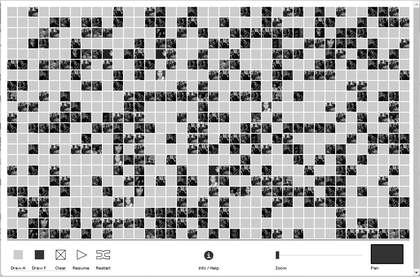
Fig.1
Screenshot of the start screen for the 2006 version of The Battle of Algiers by Marc Lafia and Fang-Yu Lin, with the original user interface, as emulated on the Whitney’s artport site.
© 2006-2018 Marc Lalia and Fang-Yu Lin.
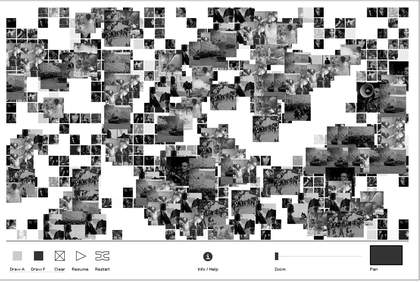
Fig.2
Screenshot of the 2006 version of The Battle of Algiers, after five minutes, featuring a random constellation of cells.
© 2006-2018 Marc Lalia and Fang-Yu Lin.
On opening the webpage, visitors see a rectangle of grey squares, randomly filled with details of stills from the film (fig.1). At this point the user has the option to ‘draw’ their own ‘story’ by arranging French (F) and Algerian (A) film stills in squares to fill the grid. Alternatively, the user can allow the composition of squares to develop – shifting size, position and spacing – according to the algorithms developed by the artists. After a few moments, a collage of sounds and voices from the film begins playing, creating a jarring soundtrack to accompany the shifting movement of images on the screen. As you watch, increasing amounts of the page’s space – or territory – is occupied with excerpts of the still images from the film (fig.2). The story can be cleared at any time and a new version created.
The film by Pontecorvo that served as the starting point for the artwork explores the Algerian War of Independence in the 1950s and early 1960s, between the Algerian National Liberation Front (FLN) and France. Pontecorvo’s film focuses on events that took place between 1954 and 1957 in the ‘backstreets and alleys of the Algiers Casbah’.3 Through this ‘battle’, Pontecorvo captures ‘the organisation of a guerrilla movement and the methods used to decimate it by the colonial power’.4 It was filmed in the locations at which the war had taken place only a few years before, with mostly non-professional actors including people who had been involved in the conflict. This, combined with handheld camera and grainy imagery, gave the film a documentary feel.5 It generated controversy upon its release in France, and was initially banned by the French government for its portrayal of French colonisers.6 Because of the way the film shows the guerrilla warfare tactics of the FLN, it has become a reference guide for guerrilla warfare, reportedly used by the Black Panthers, the IRA and by the US Army.7 In 2003, the Pentagon screened the film to civilians and the military as a training tool for guerrilla warfare in Afghanistan and Iraq.8
Making and commissioning
The Battle of Algiers was one of three net art works co-commissioned for the Whitney’s artport and Tate’s net art websites.9 Around 2005, Lafia wrote a proposal to curator Christiane Paul at the Whitney. There, Lafia expressed an interest in questioning whether ‘computation could be used to performatively visualise [The Battle of Algiers] in a spatial way’.10 To help develop this ambition, Paul put Lafia in touch with Fang-Yu Lin, a new media artist skilled in programming interactive design. The project evolved through co-design into a joint commission, with the artists equally credited as collaborators.11
Interested in the film’s representation of the two sides’ approaches to war, Marc Lafia and Fang-Yu Lin set about transforming Pontecorvo’s film into ‘computational matter’.12 They translated the actions, strategies and behaviours taken by the Algerian FLN and the French nationalists in the film into algorithms and code. The French nationalists, for example, had a top-down, hierarchical approach, while the FLN was structured like a pyramid ‘with sections composed of triangles’.13 Lin translated the strategies depicted in the film into algorithms.14 The still images are then combined with sounds from a database. As Lafia describes, this approach allowed the artists to ‘performatively understand how this cellular strategy, graphically and as an algorithm, as a rule set, performs very differently than this other rule set’.15 By remediating the film into a digital database, a ‘contestation between power and insurgency’ could be performed and interacted with by people on the website.16
The work was updated in 2018, when it was transformed for an app and displayed in Programmed: Rules, Codes, and Choreographies, 1965–2018 at the Whitney Museum of American Art, New York (28 September 2018 – 14 April 2019), an exhibition looking to establish ‘connections between works of art based on instructions, spanning over fifty years of conceptual, video, and computational art’.17 The Battle of Algiers was included in the section titled ‘Signal, Sequence, Resolution: Realities Encoded’ and framed in terms of the way ‘artists use programming to adopt a critical stance by underscoring or exposing social, cultural or political codes’.18
Working with Whitney conservator Carol Mancusi-Ungaro, the artists adapted several aspects of the work for the exhibition, including the user interface. Christiane Paul has spoken about the importance of recognising the difference between interacting with the work privately on a screen and experiencing it in a gallery, as ‘people in physical space behave very differently, they need different prompts, you can’t just install a work the same way’.19 To achieve this, the artists undertook user testing in the gallery space as they developed the new version of the work.
From Lin’s perspective, the aim of the upgrade in 2018 was to conserve the ‘original manifestation of our concept, that is a database cinema... using modern technology’.20 The artists also wanted the user interface to be more in keeping with current design and behaviours. In interviews with the Reshaping the Collectible team, the artists highlighted how much user experience and interaction on the web has changed since 2005. Lafia explains: ‘We did the project prior to what we can call Web 2.0 [and prior to the] global phone. So, when people go to an interface such as ours, their expectations are at an entirely different level in terms of the kinds of immediacy, the reaction, the kind of graphics, the kind of manipulation’.21 Despite the huge advances in processing and internet speeds, however, in the 2018 version the artists decided to ‘replicate the original speed’ of the 2006 version.22
Meaning and interpretation
The Battle of Algiers explores the concept of ‘database cinema’ developed by artist and theorist Lev Manovich.23 Database cinema is a term used to describe the automated authoring of linear narratives from databases of clips. These databases are either created by the artist or scraped from online content – an approach artists Thomson & Craighead have called ‘template cinema’ in their online works from the same period.24 The processes used to create database or 'template' cinema often include establishing rules or protocols – tagging and organising them based on characteristics such as length, perspective, camera angle or source – and using those rules to call content from a database into a filmic structure . This assembly could happen in real time and run endlessly in a form of generative artmaking.
The artists were living in New York when they worked on the commission, in the aftermath of 9/11 and during the Iraq war (2003–11). Lin and Lafia have reflected on the importance of this context to the work. Lin asks, for instance: ‘Is there a way we can let the audience truly realise the context of the time?’.25 He recognises this as a key question to the work’s conservation: ‘in a sense, you cannot truly preserve a digital piece, because the context is not there’.26 In 2006, when The Battle of Algiers was created, the internet enabled wide-ranging interaction and engagement without the permissions and controls that operate today on social media platforms, such as Facebook. As Lafia has reflected: ‘I think there’s this period from 1997 to 2004 whereby you have this thing called net art… where the network could be a medium in which you could play with some of the protocols and the rules of the data’.27
Reception and criticism
In his essay on The Battle of Algiers commissioned for the Tate and Whitney websites, philosopher Daniel Coffeen analyses the deconstruction of linear storytelling in Pontecorvo’s film and the further distribution and fragmentation in Lafia and Lin’s creation. He describes the artwork as a ‘cinema-machine’ that upends received ideas of narrative, power and politics:
If Pontecorvo teaches us that story is a dictatorial power that suppresses the movement of the image, Marc Lafia’s and Fang-Yu Lin’s The Battle of Algiers is nothing less than a revolution. Or perhaps ‘revolution’ is the wrong word. We’ve left the realm of the reel that goes around and around and entered a new territory. The byte has splayed the reel, excavating, expanding and exploding its nascent multiplicity. This The Battle of Algiers does not as much offer a revolution as a proliferation – which may, after all, be the true revolution.28
Developing a similar line of enquiry, theorist Cristiano Poian proposes that The Battle of Algiers ‘bends the narration to the algorithm’ to show ‘multi-dimensionality of French-Algerian conflict’.29 Drawing on Manovich’s theory of the ‘era of the database’,30 he goes on to describe how, ‘every piece moves according to a set of rules programmed by the authors: when the different fronts collide, the software plays in that board position a fight sequence of the original film’.31
In an article written shortly after The Battle of Algiers went live, writer Amber Ladd draws on Coffeen’s comments that ‘film is a database of images run together’, to propose that the medium itself is the basis of Lin and Lafia’s investigation.32 She considers how Pontecorvo’s film suits Lafia and Lin’s transformation of it into data and algorithm because it does not follow a single narrative or protagonist. Ladd also places the work in an art-historical context by asserting that it ‘echoes minimalist artworks such as the grid and monochromatic palettes’.33
The artists’ practice
Marc Lafia works across film, networked media, photography and information design. After starting out in film, he became increasingly interested in working online. For Lafia, ‘the browser was a new instrument. It was a new viewfinder. It was a new way to bring things to you’.34 The portable, networked nature of the internet and its potential for subversive behaviour enabled Lafia to develop experiments with the remediation and reworking of linear film structures. It became ‘a very good way to re-analyse, re-take apart these older media and these other messages’.35 An earlier example of this approach is Lafia’s interactive game Vanndemar Memex or Lara Croft Stripped Bare by her Assassins, Even 1999, created in collaboration with Gabriella Marks, Darin Fong, Mark Meadows and Josh Draper.36 Vanndemar Memex was inspired by the ideas of ‘extended self, distributed narrative, artificial life, collective intelligence and emergent systems’ and considers the ability of engines or technologies to create artworks.37 It takes the form of an episodic game which users play as an avatar.
Fang-Yu Lin creates works in new media and design that demonstrate an interest in the interplay between humans, culture and technology. With From the Great Beyond 2004–05, for example, a typewriter is used as a conduit for people to hold a conversation with the internet.38 In Political Science 101 2008 the artist creates a study of blogs as a political medium.39
Technical narrative
The Battle of Algiers was produced using Adobe Flash (Flash) and ActionScript. The work is built on a database in which details of film stills and audio clips are organised by attributes defined by the artists, including whether the images of characters shown are from the Algerian or French forces. The film still tiles initially appear on the board in random constellation. Visitors can also ‘draw’ their own image by selecting squares on the main grid and defining them as either Algerian or French forces. The squares on the grid then change according to the algorithms created by the artists to represent the strategies of the two sides of the conflict.
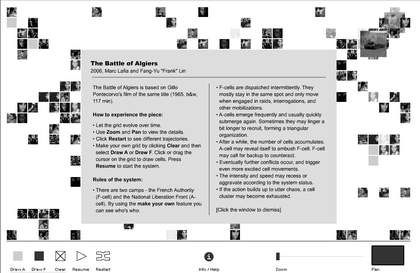
Fig.3
Screenshot from the Whitney’s artport site showing ‘info-help’ pop-out window
© 2006-2018 Marc Lalia and Fang-Yu Lin.
In the 2018 version of the work, a pop-out ‘info-help’ panel describes the basic attributes of the work and serves as a guide for the user (fig.3). It includes both straightforward instructions on how to experience the piece, such as ‘let the grid evolve over time’, and more detailed ‘rules of the system’ that outline the behaviours of the different cells. For instance, F (French) cells ‘mostly stay in the same spot and only move when engaged in raids, interrogations and other mobilizations’, while A (Algerian) cells, ‘emerge frequently and usually quickly submerge again. Sometimes they may linger a bit longer to recruit, forming a triangular organisation’.
There were two key drivers for the artists to update the work in 2018: firstly, the announcement about Flash’s end of life scheduled for 2020 and, secondly, the need to adapt the work for a gallery context ahead of its inclusion in the Whitney exhibition that year. The latter meant rethinking the scale of the work, from the privacy of a personal computer screen to a large screen in a public gallery, surrounded by other visitors.
In the process of adapting the work, Fang-Yu Lin discussed the importance of conserving the 2006 manifestation of The Battle of Algiers.40 To do so, the artists used OpenFL, a free and open-source software created to mirror the Flash API. OpenFL supports the programme language Haxe, which was used to create the JavaScript web app as well as native Windows and Mac applications that can be downloaded from the artists’ website.41
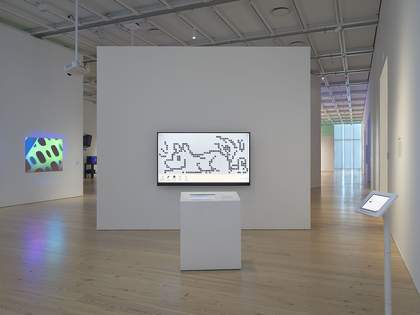
Fig.4
Battle of Algiers installed in Programmed: Rules, Codes and Choreographies in Art 1965–2018 at the Whitney Museum of American Art, New York, showing the new interface developed for the exhibition
© 2006-2018 Marc Lalia and Fang-Yu Lin.
Photo: Ron Amstutz, courtesy Whitney Museum of American Art, New York
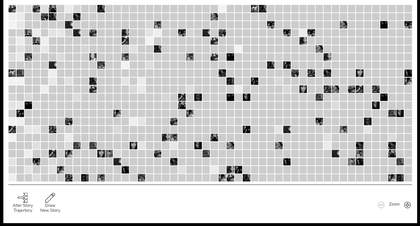
Fig.5
Start screen of the 2018 version of The Battle of Algiers, featuring the redesigned user interface
© 2006-2018 Marc Lalia and Fang-Yu Lin.
In redesigning the interface for the Whitney exhibition, the artists chose to remove the ‘info-help’ window and include it as a label next to the touchscreen that visitors could use to interact with the work (fig.4). The ‘buttons’ were also altered so that, unlike in the 2006 version, there are two levels; the first gives users a choice between ‘Alter Story Trajectory’ and ‘Draw New Story’ (fig.5). The ‘Alter Story Trajectory’ option places cells randomly on the board, while ‘Draw New Story’ adds three buttons: to select Algerian or French cells and to start playing. The zoom option is consistent across both versions and all boards. The artists consider the two versions to be the same artwork, as they are based on the same database and system of rules. A user would see the same images, sounds and evolution of the cells in the grid in both iterations.
The fact that The Battle of Algiers was originally a self-contained Flash application made it a perfect candidate for emulation. On the Whitney’s artport page, the 2006 version of the work runs on Ruffle, an open-source Adobe Flash Player emulator that allows Flash content to be safely run online. In collaboration with the artists, Christiane Paul and her team at the Whitney have found ways to display this artwork and adapt it to a current audience, while maintaining its historical version online. Given this continued engagement from both the institution and the artists, the work is considered low risk in terms of preservation. The existence of the two versions, and the improvement in the tools supporting emulation of Flash, mean that when updates are needed there will be two possible paths to preservation. Any future changes to the work can also be made with the knowledge of the artists’ priorities and decision-making process.
Conclusion
The Battle of Algiers was made at a time when artists were expanding the possibilities of online interactive works and exploiting the seemingly greater freedom to reuse, remix and rewrite the rules of other media in their works. Lev Manovich’s conceptualisation of ‘database cinema’ in 1999 was echoed in contemporaneous artworks by Jennifer and Kevin McCoy, in which they exhaustively clipped and categorised popular television shows and movies, inviting audiences to search and remix them. In I Number the Stars 2004, for example, the artists break down the first season of the popular science fiction television series Star Trek (1966) into a series of shots categorised by keywords such as ‘events’ and ‘emotions’.42 The Battle of Algiers can also be read in light of Man with a Movie Camera: The Global Remake 2007, for which artist Perry Bard broke down Dziga Vertov’s film of the same name into individual shots and invited people to upload alternative interpretations of each to a website. People could recreate the frames in any way they chose. Each day, the software would pull a random shot from a database to reconstruct a new crowdsourced version of Man with a Movie Camera, so that ‘infinite versions of the film are possible’.43
The co-commission should also be understood as a continuation of the net art scene that emerged in the UK around the turn of the millennium, including the work of Desperate Optimists (Joe Lawlor and Christine Molloy). For their Flash-based work Map 50 2000, the collective produced sixty-three short episodes of an online ‘soap opera’, with each episode tied to a location on an online map of north London, enabling users to unfold the narrative over time and space.44 Desperate Optimists were subsequently invited by the London Film and Video Development Agency to create Minute by Minute 2002, an online project in which users followed a list of rules to submit one-minute films about Newham, east London. These films were then remixed with text and sound by visitors to the site. Like The Battle of Algiers, these projects combine experiments in interactivity using Flash with a focus on the representation of conflict in film media (in Desperate Optimists’ work, the conflict is between past and present, rich and poor, property developers and creatives). The disconnect between the game-like programming and the subject matter of The Battle of Algiers reveals the futility of attempts to capture or represent all perspectives in a conflict, including that of Gillo Pontecorvo in the original film.
